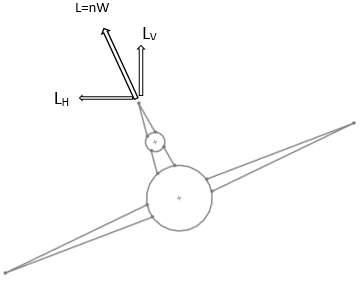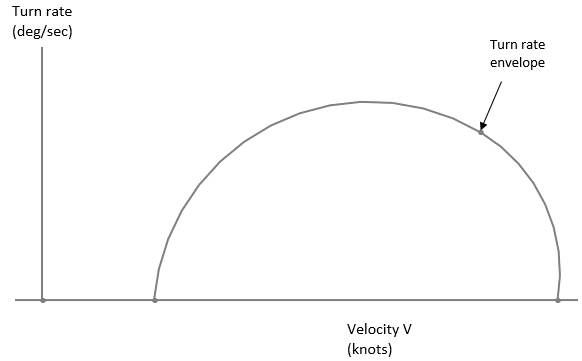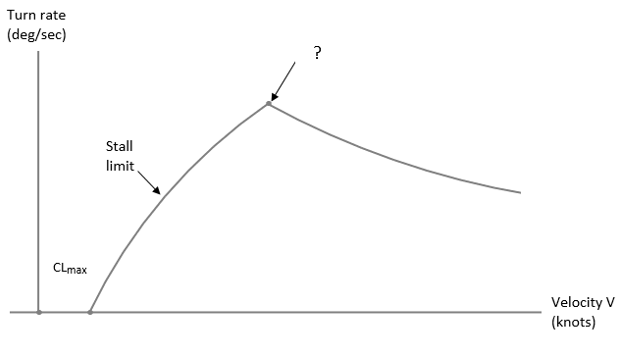This set of Aircraft Design Multiple Choice Questions & Answers (MCQs) focuses on “Flight Mechanics – Level Turning Flight”.
1. Corner speed is defined as __________
a) velocity for maximum instantaneous turn
b) maximum lift velocity
c) maximum aerodynamic efficiency
d) minimum instantaneous turn speed
View Answer
Explanation: Velocity for maximum instantaneous turn is termed as corner speed. Corner speed is defined by intersection of the stall limit and the Structural limit. For a typical fighter, corner speed can vary between 300 to 350 knots.
2. During level turning flight, lift of wing is canted.
a) True
b) False
View Answer
Explanation: In a typical level turning flight Maneuver, the lift of the wing is canted. As a result of this, horizontal component of the lift will exert the centripetal force required to turn. Typically, total lift is n times more than that of the weight of an aircraft. Hence, the above statement is true.
3. If load factor of level turning flight is found to be 1.2 and flight speed is 120m/s then, determine turn rate.
a) 3.107 degree/s
b) 1.2 rad/s
c) 0.03 rad per second
d) 1.2
View Answer
Explanation: Given, load factor n=1.2, flight speed v=120m/s
Turn rate = \(\frac{g*\sqrt{n^2-1}}{v}\)
= \(\frac{9.81*\sqrt{1.2^2-1}}{120}\)
= 0.054 rad/s = 3.107 degree/s.
4. Let’s consider we are designing an aircraft which can have 0.075 rad/s as its turn rate during level turning operation. If load factor is set to be 1.1 then, at which velocity we should fly our aircraft to obtain mentioned requirement.
a) 59.8unit
b) 590unit
c) 5980unit
d) 0894unit
View Answer
Explanation: Given, load factor n=1.2, Turn rate = 0.075 rad/s
Velocity V = \(\frac{g*\sqrt{n^2-1}}{turn \,rate}\)
= \(\frac{9.81*\sqrt{1.2^2-1}}{0.075}\) = 59.8 unit.
5. Following diagram represents ____________

a) level turn
b) lift curve slope
c) mach number limit
d) drag polar
View Answer
Explanation: A typical level turn is shown in the diagram. Lift curve slope is defined as the ratio of the change in lift coefficient and the change in AOA. Mach number limit is concerned with propulsion. Drag polar is graphical representation of drag.
6. During level turning operation my aircraft has load factor of 2. Find the required bank angle for this level turning operation.
a) 60°
b) 60rad
c) 120rad
d) 2.1rad
View Answer
Explanation: Bank angle = arccosine (1/load factor) = arccosine (1/2) = arccosine 0.5 = 60°.
7. What will be the turn radius if flight speed is 50unit and load factor is 2? Consider Level turn.
a) 147.13unit
b) 180unit
c) 50unit
d) 20unit
View Answer
Explanation: Given, load factor n=2, velocity v=50 unit
Turn radius = \(\frac{v*v}{g*\sqrt{n^2-1}}\)
= \(\frac{50*50}{9.81*\sqrt{2^2-1}}\)
= 147.13 unit.
8. If an aircraft can slow down during turn then, it is termed as __________
a) instantaneous turn
b) non instantaneous turn
c) straight flight
d) cruise segment
View Answer
Explanation: If an aircraft can slow down during turn then, it is termed as Instantaneous turn. Here, load factor will be limited by maximum lift coefficient or structural strength of the aircraft. Cruise segment is part of mission profile of an aircraft. At cruise all forces and moments are balanced.
9. Following diagram represents _____________

a) sustained turn rate envelope
b) instantaneous turn rate
c) power required diagram at 3 km
d) lift curve for wing
View Answer
Explanation: Above diagram is illustrating the concept of turn rate. Typical sustained turn rate at an altitude is shown in the diagram. Above diagram is illustrating the concept of Sustained turn rate envelope.
10. The aircraft _____________ during a sustained turn.
a) cannot be slowed down
b) can be slowed down
c) can lower its velocity
d) can increase lofting process effort
View Answer
Explanation: In sustained turn, aircraft is not allowed to slow down. During sustained turn aircraft cannot be slowed down or lose altitude during turn. In sustained turn thrust has to be equal to the drag. Lift is load factor times weight.
11. An aircraft is in sustained turn with thrust loading of 0.8 and aerodynamic efficiency of 6. Determine the approximate value of maximum load factor.
a) 4.8
b) 3
c) 1
d) 12
View Answer
Explanation: Maximum load factor = thrust loading*aerodynamic efficiency=0.8*6 = 4.8.
12. Term marked by ’?’ in the following diagram is called __________

a) corner speed
b) dive speed
c) cruise speed
d) free stream velocity
View Answer
Explanation: Above diagram is showing a typical relationship between turn rate and velocity. Above diagram is illustrating the concept of corner speed. Corner speed is velocity required for maximum instantaneous turn. Cruise speed of an aircraft is speed required to attain cruise condition or steady level flight.
13. An aircraft weighing 200kg is in level turning operation. Find the value of vertical component of lift.
a) 1.962 KN
b) 200N
c) 2KN
d) 0.2KN
View Answer
Explanation: Given, mass = 200kg
Weight = 200*9.81 = 1962 N. At Level turn, Vertical component of lift is equal to weight.
Hence, for given level turning flight Maneuver, vertical component of lift = weight = 1962N = 1.962KN.
14. Turn rate is defined as _______
a) ratio of radial acceleration and the velocity
b) ratio of lift to drag
c) product of thrust and velocity
d) drag
View Answer
Explanation: Turn rate is defined as the ratio of radial acceleration Divided by the velocity. Typically, turn rate is denoted by degree per second. Lift to drag ratio is called aerodynamic efficiency of the aircraft. Thrust into velocity will result in power.
Sanfoundry Global Education & Learning Series – Aircraft Design.
To practice all areas of Aircraft Design, here is complete set of 1000+ Multiple Choice Questions and Answers.
If you find a mistake in question / option / answer, kindly take a screenshot and email to [email protected]
- Practice Aerospace Engineering MCQs
- Check Aircraft Design Books
- Check Aerospace Engineering Books
- Practice Aeronautical Engineering MCQs
- Check Aeronautical Engineering Books
